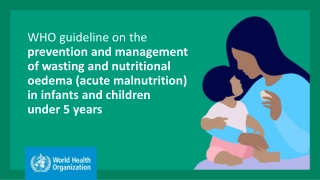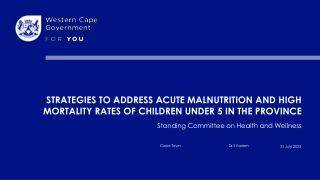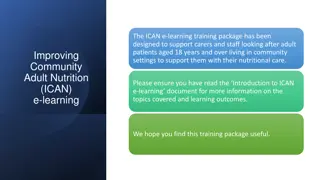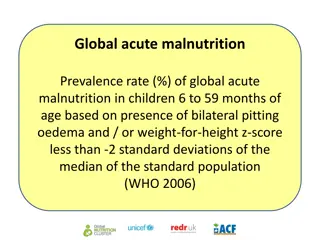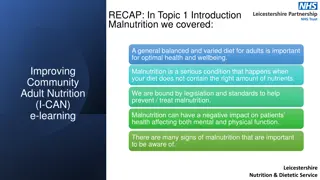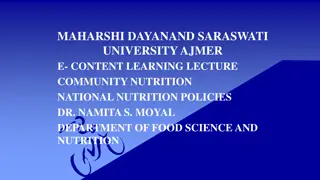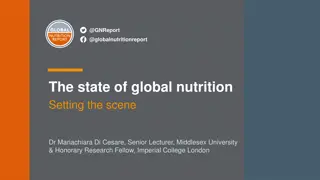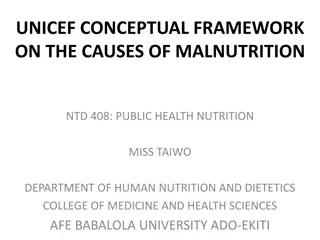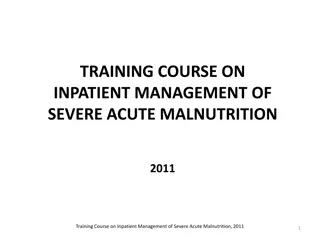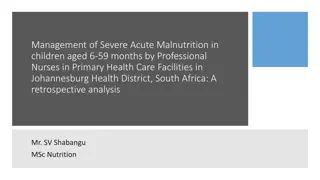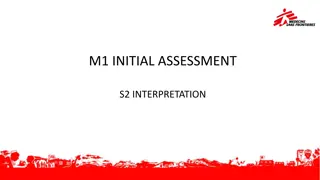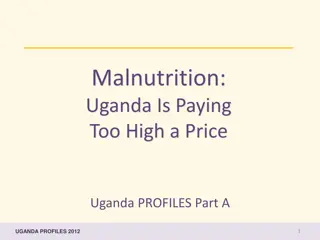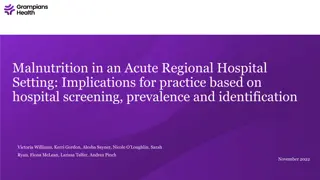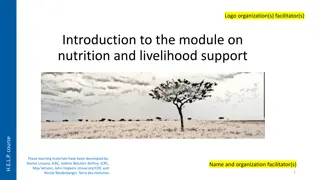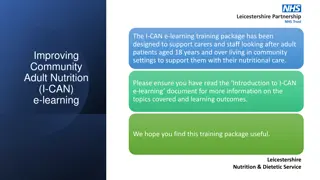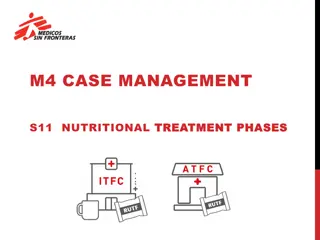Managing Malnutrition in Children
Learn about malnourishment in children, including common types like Kwashiorkor and Marasmus, as well as the physiologic consequences and clinical assessments related to malnutrition. Discover key indicators such as weight-for-height, MUAC, and edema, along with micronutrient deficiencies and how they impact a child's health. This comprehensive overview provides insights into identifying, treating, and preventing malnutrition in young individuals.
Download Presentation

Please find below an Image/Link to download the presentation.
The content on the website is provided AS IS for your information and personal use only. It may not be sold, licensed, or shared on other websites without obtaining consent from the author.If you encounter any issues during the download, it is possible that the publisher has removed the file from their server.
You are allowed to download the files provided on this website for personal or commercial use, subject to the condition that they are used lawfully. All files are the property of their respective owners.
The content on the website is provided AS IS for your information and personal use only. It may not be sold, licensed, or shared on other websites without obtaining consent from the author.
E N D
Presentation Transcript
CME on the malnourished child Dr Siri Maartensson Mr Ribson K Rop, Clinical Nutrition Officer Kacheliba Sub-County Hospital 03/10/2023
Definition W/H weight for height, relative to standard weight of healthy child. Z-score -2 SD MAM (moderate acute malnutrition) Z-score -3 SD SAM (severe acute malnutrition) MUAC (mid upper arm circumference), degree of muscle wasting Ages 1-5 yrs <11,5 SAM 11,5-12,5 MAM 12,5-13,5 at risk Lower-limb oedema, periorbital oedema
Malnourishment in children (combination common) Kwashiorkor Protein deficiency Low-normal MUAC, W/H Oedema bilateral pitting oedema, periorbital oedema Skin changes Hair changes dry, thin hair Hepatomegaly Miserable, lethargic, apathetic Marasmus Protein and energy deficiency Wasting low MUAC, W/H Thin, flaccid skin, prominent spine/ribs/pelvis Alert, irritable Distended abdomen (weakened muscles + gas from small bowel bacterial overgrowth)
Kwashiorkor Kwashiorkor Marasmus Marasmus
Patophysiological consequences Anaemia ( free iron inflammation, infection, cell membrane dysf.) Compromised immune system very susceptible to infection Decreased barrier of skin, gut, respiratory tract Decreased systemic immunity Electrolyte imbalance Ca2+, K+, Zn2+, Mg2+, Cu2+ Metabolic disturbances, susceptible to hypoglycemia, hypothermia Reduced gut mobility, bacterial overgrowth, villous atrophy, gut enzyme deficiencies impaired digestion and absorption Muscle wasting
Micronutrient deficiencies Vitamin A xerophtalmia (night blindness, corneal ulcers etc) Vitamin C scurvy (impaired collagen, bleeding gum etc) Iron/Folate/B12 anaemia Vitamin D/Calcium rickets (bone deformity) Vitamin K blood clotting abnormalities Iodine goitre (thyroid growth)
Clinical assessment - history Concurrent illness/symtoms Vomiting/diarrhoea? frequency, duration, nature (postprandial?) Recent malaria, respiratory tract infection etc Behaviour changes, irritability, apathy? Feeding history Appetite? Thirst? Food and fluid intake last days? Breastfeeding mixed/exclusive? How often and long? Growth history Premature? Twin? Growth chart available? Other medical/family history HIV/AIDS of mother or child? Development milestones reached? Immunization status? Vitamin A supplements? TB contact?
Clinical assessment further examination Physical examination General appearence, behaviour, mood, level of consciousness Pallor? Jaundice? Fever? Hydration assessment difficult (SAM causes similar clinic) important to take history! Urine output? D/V? Abdomen distended? Hepatosplenomegaly? Skin changes/infection? Rashes? Oedema lower-limb, facial Lab FHG, at least Hb PITC RBS Possibly U/A - rule out severe proteinuria (nephrotic syndrome), check for UTI BS for MP s Appetite test
Phases of treatment 1. Stabilization phase Low protein/fat/energy feeds (F-75) re-start metabolic and physiological processes, clear oedema (will loose weight initially). Usually 8 feeds/d. Treat medical complications No iron supplements! (pro-inflammatory can promote infection) 2. Transition phase Once appetite return, oedema clears, medical complications are treated (usually 3-7 days) Possible to increase dietary intake, switch to F-100/RUTF. Gradually increase amount. 3. Rehabilitation phase Once tolerating feeds, not loosing weight To promote rapid growth. Usually 5 feeds/d.
Therapeutic nutrition Initial cautious feeding re-start metabolic processes, improve absorption. Risk of overloading fragile system! Therapeutic feeds protein, energy, fats, micronutrients, vitamins. No iron in F-75/F-100. F-75 75kcal, 0.9g proteins/100 ml. Stabilization phase. F-100 100kcal, 2.9g protein/100 ml. Transition/rehab phase. RUTF approx. 500 kcal/92g sachet. Transition/rehab phase. Long shelf life, suitable for outpatient treatment.
Treatment of medical complications Blood transfusion if needed, caution to avoid fluid overload Initial antibiotics Severe infection might not be as symtomatic as in healthy child. Might present with hypothermia, hypoglycemia, lethargic appearence. Immune response decreased high risk of infection Nystatin if signs of oral candidiasis Albendazole after stabilization Avoid iron supplements until stable, increases risk of infection
Dehydration/diarrhoea Diarrhoea common due to e.g infection, osmotic load of the food, lactose intolerance. Oral resuscitation preferred. F-75/F-100 contains Zn. ReSoMal instead of regular ORS contains Na+, K+ Resuscitate, approx. 70-100ml/kg in the first 12 hours (5ml/kg every 30 min) Then give after every loose stool Therapeutic foods will facilitate recovery of mucosa and restore digestive enzymes, gastric acid and bile.
EDIT Following slides prepared by hospital nutritionist Mr Ribson K Rop.
Calculation of feeds: Calculation of feeds: F-75 For severe oedema, start with 100 mls/kg bwt/day Wasting/marasmus only- 130ms/kg bwt/day Case 1 Edematous Child has weight of 8.9kg, what is the feed? =100ms 8.9 8 feeds , incase of three hourly feed =100mls 8.9 12 feeds, incase of two hourly feed
Case 2 Case 2 Child 1: 6.8kg, no oedema , 3 hourly feed?............. Child 2: 8.5 kg, mild (+) oedema, 2 hourly feed? Child 3: 5.2 kg, severe (+++) oedema, 2 hourly feed? .. NOTE: For F100, child have fully gained appetite and oedema resolved, so the amount of feed 130 mls/kg/day
Feeding Feeding It is best to feed the child with a cup Encourage the child to finish the feed. It may be necessary to feed a very weak child with a dropper or syringe. Do not use a feeding bottle. Never leave the child alone to feed. Catch dribbles by holding a saucer under the cup
FEEDING UTENSILS FEEDING UTENSILS
AFTER FEED AFTER FEED a. Record the amount of feed offered. b. After offering the feed orally, measure and record the amount left in cup. c. Subtract the amount left from the amount offered to determine the amount taken orally by the child. d. If necessary, give the rest of the feed by NG tube and record this amount. e. Estimate and record any amount vomited (and not replaced by more feed). f. Ask whether the child had watery diarrhea (any loose stool) since last feed. If so, record yes .
Difference (F Difference (F- -75 F100) 75 F100)


